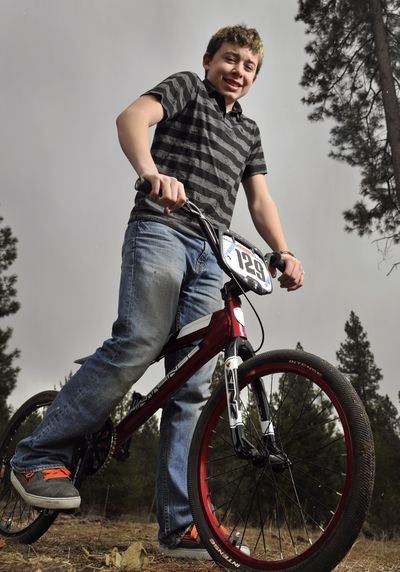Hospital’s refocus a lucky break for boy
BMX accident brought teen to Shriners for specialized care

Brenden Essig remembers hearing “Watch out!” before everything went dark.
A minute or so later the 13-year-old attempted to shake off the BMX bike crash, a wicked collision of body and packed dirt. He stood up and then collapsed.
“I was numb,” he said.
Essig had just finished his first day of eighth grade in September and was participating in an evening practice with his BMX racing team at a course near Joe Albi Stadium.
Day 2 of school would have to wait.
The accident snapped his right arm above the elbow.
Call it luck that the break wasn’t an inch closer to the joint, in the bone-building area called the growth plate.
Call it serendipity that Shriners Hospital for Children has a surgery center in Spokane staffed with specialists trained to work on kids who have complicated orthopedic traumas.
For decades the hospitals operated as a renowned charity, providing free care for children with birth defects and other conditions. It wasn’t until just a few years ago that Shriners dropped “crippled” from its name.
But the hospitals have been working to broaden their appeal as a place to treat any child with fractures. That service combines Shriners’ longtime expertise in caring for children with a specialty in pediatric orthopedics; its surgeons take more than a year of extra training in the specialty before going into practice.
From 2010 to 2011, the number of patients treated for broken bones at Shriners in Spokane doubled to 10 per month. That’s in addition to about 60 other surgeries performed each month at the hospital.
Dr. Paul Caskey, medical director at Shriners, says many physicians and orthopedic surgeons would rather avoid working with children.
“Children are different. They’re not little adults. They’re still growing,” he said. “They have different needs.”
The Essigs won’t be billed for Brenden’s care, which will include a follow-up visit in August to remove a plate and seven screws.
The hospital now accepts insurance dollars, though it declines to accept co-pays and vows it won’t send a bill to the family of any patient.
This week Shriners announced an agreement to be in the network of regional heavyweight Premera Blue Cross.
“The doctors here don’t know who’s insured and who isn’t, and frankly, I’m not sure we want to know or even care to know if a kid is insured,” Caskey said. “A family’s ability to pay simply shouldn’t matter.”
After his accident, Brenden, who’s now 14, was taken by his sister and father to Providence Holy Family Hospital, where his mom, Debbie, is an emergency room nurse.
The staff cut away his favorite shirt and snipped off his elbow pads. They fed him painkillers, took an X-ray, wrapped his arm tight and quickly decided to send him to Shriners in the morning.
After a long night he arrived at Shriners and underwent a four-hour surgery with Dr. Glen Baird.
Six months later, Brenden is back on his BMX. He’s not yet racing with abandon; that comes later.
The ordeal left Brenden with a thick scar. It matches the scar on his father’s right arm, earned when Ken also was 13 and wiped out during a motocross race.
“Makes you wonder, doesn’t it?” Brenden said.